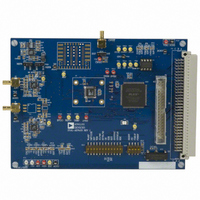EVAL-AD7655CB Analog Devices Inc, EVAL-AD7655CB Datasheet - Page 11

EVAL-AD7655CB
Manufacturer Part Number
EVAL-AD7655CB
Description
BOARD EVAL FOR AD7655
Manufacturer
Analog Devices Inc
Series
PulSAR®r
Specifications of EVAL-AD7655CB
Number Of Adc's
1
Number Of Bits
16
Sampling Rate (per Second)
1M
Data Interface
Serial, Parallel
Inputs Per Adc
4 Single Ended
Input Range
0 ~ 2 V
Power (typ) @ Conditions
120mW @ 1MSPS
Voltage Supply Source
Analog and Digital
Operating Temperature
-40°C ~ 85°C
Utilized Ic / Part
AD7655
Lead Free Status / RoHS Status
Contains lead / RoHS non-compliant
TERMINOLOGY
Integral Nonlinearity Error (INL)
Linearity error refers to the deviation of each individual code
from a line drawn from negative full scale through positive full
scale. The point used as negative full scale occurs ½ LSB before
the first code transition. Positive full scale is defined as a level
1½ LSBs beyond the last code transition. The deviation is
measured from the middle of each code to the true straight line.
Differential Nonlinearity Error (DNL)
In an ideal ADC, code transitions are 1 LSB apart. Differential
nonlinearity is the maximum deviation from this ideal value,
and is often specified in terms of resolution for which no
missing codes are guaranteed.
Full-Scale Error
The last transition (from 111. . .10 to 111. . .11) should occur for
an analog voltage 1½ LSBs below the nominal full scale
(4.999886 V for the 0 V to 5 V range). The full-scale error is the
deviation of the actual level of the last transition from the ideal
level.
Unipolar Zero Error
The first transition should occur at a level ½ LSB above analog
ground (76.29 μV for the 0 V to 5 V range). The unipolar zero
error is the deviation of the actual transition from that point.
Signal-to-Noise Ratio (SNR)
SNR is the ratio of the rms value of the actual input signal to the
rms sum of all other spectral components below the Nyquist
frequency, excluding harmonics and dc. The value for SNR is
expressed in decibels.
Rev. B | Page 11 of 28
Total Harmonic Distortion (THD)
THD is the ratio of the rms sum of the first five harmonic
components to the rms value of a full-scale input signal and is
expressed in decibels.
Signal-to-Noise and Distortion Ratio (SINAD)
SINAD is the ratio of the rms value of the actual input signal to
the rms sum of all other spectral components below the Nyquist
frequency, including harmonics but excluding dc. The value for
SINAD is expressed in decibels.
Spurious-Free Dynamic Range (SFDR)
The difference, in decibels, between the rms amplitude of the
input signal and the peak spurious signal.
Effective Number of Bits (ENOB)
ENOB is a measurement of the resolution with a sine wave
input. It is related to SINAD and expressed in bits by
Aperture Delay
Aperture delay is a measure of acquisition performance and is
measured from the falling edge of the CNVST input to when
the input signals are held for a conversion.
Transient Response
The time required for the AD7655 to achieve its rated accuracy
after a full-scale step function is applied to its input.
ENOB = (SINAD
dB
− 1.76)/6.02
AD7655




















